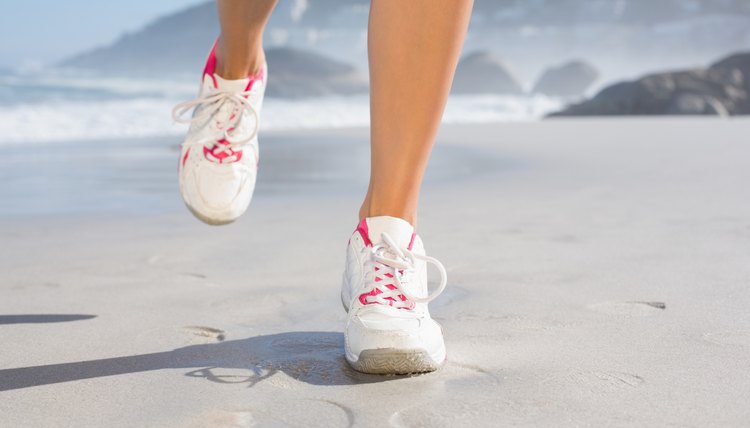What does fact checked mean?
At SportsRec, we strive to deliver objective content that is accurate and up-to-date. Our team periodically reviews articles in order to ensure content quality. The sources cited below consist of evidence from peer-reviewed journals, prominent medical organizations, academic associations, and government data.
- Journal of Orthopedic Sports Physical Therapy: Effect of Positive Heel Inclination in Posture
- Journal of Orthopedic Sports Physical Therapy: Effect of Positive Heel Inclination in Posture
The information contained on this site is for informational purposes only, and should not be used as a substitute for the advice of a professional health care provider. Please check with the appropriate physician regarding health questions and concerns. Although we strive to deliver accurate and up-to-date information, no guarantee to that effect is made.
Heel Walking Exercise

Shin and ankle pain may put a damper on your aerobic activities. Improper footwear, frequently wearing high heels and poor posture have an adverse effect on the lower leg anatomy. Physical therapists use the heel walking exercise as a diagnostic tool for gait disorders and as a rehabilitation exercise for lower leg injuries and muscle imbalances.
Identification
The heel walking exercise requires you to stand in an upright position, lift your toes from the floor and walk around the room without flattening your feet. Some physical therapists progress the exercise by having the patient begin with a heel strike and then roll the rest of the foot toward the floor or sidewalk.
Function
The tibialis is the long muscle that supports your shin. Dorsi flexing your feet, or curling your toes toward your shins, activates this muscle group. Orthopedic specialists on the Rehabmanual website explain that people with weak ankle dorsiflexors will slap their foot down instead of allowing it to land smoothly. Heel walking balances the dorsiflexors with the plantar flexors, which are the muscles that point your toes toward the floor.
Prevention/Solution
Women who frequently walk in high heels adapt a toe-to-heel walking stance, which weakens the lower leg muscles. This walking pattern may even affect your pelvic alignment and cause back problems, reports M.E. Franklin, lead author of a 1995 study published in the "Journal of Orthopedic Sports Physical Therapy." Minimizing time in high heels, and correcting the lower leg imbalance by performing the heel walking exercise, may correct the problem.
Benefits
Heel walking may also benefit performance in certain sports. Skiers, for example, require strong tibialis muscles and ankle dorsiflexors. If these muscles are weak, the skier will shift her weight toward the tail of the ski, which is less efficient. Breckenridge Colorado boot fitter Jeff Bergeron advises that foot beds and boot alignment will correct a skier's stance, but the boot adjustments will be more effective if the skier corrects his lower leg muscular imbalances. High-impact aerobics instructors sometimes use the heel walk in the cool-down segment of their classes as a means of balancing the lower leg muscles and preventing shin splints.
Expert Insight
A heel-first walking gait is more efficient, reports C. B. Cunningham, lead author of a study published in the "Journal of Experimental Biology." Cunningham and his team found the walking with a slightly raised heel increased the energetic cost of transport by 53 percent; reduced energy exchange from the center of mass to the lower leg muscles; increased ground reaction forces; and increased ankle, knee, hip and back extensor muscle recruitment.
The research team concluded that heel-to-toe walking is more efficient than toe-to-heel walking.
Potential
Increasing the energetic cost of recruitment means that you are exerting more energy to perform less work. Energy is generated from your center of mass, usually located 2 inches below your navel.
A toe-heel stance affects pelvic alignment and, thus, impedes energy generation. Increased ground reaction forces increase the impact of the activity and may lead to injury. Injury-prone people often have imbalances between their flexion and extension muscle groups. The quadriceps are stronger than the hamstrings, the plantar flexors are stronger than the dorsiflexiors, and the lower back muscles are stronger than the abdominal muscles.
If toe-to-heel walking, as indicated by Cunningham and his team, contributes to these imbalances, the heel walking exercise provides a potential solution.
Explore In Depth
References
Writer Bio
In 1999, Lisa Mercer’s fitness, travel and skiing expertise inspired a writing career. Her books include "Open Your Heart with Winter Fitness" and "101 Women's Fitness Tips." Her articles have appeared in "Aspen Magazine," "HerSports," "32 Degrees," "Pregnancy Magazine" and "Wired." Mercer has a Bachelor of Arts in psychology from the City College of New York.
